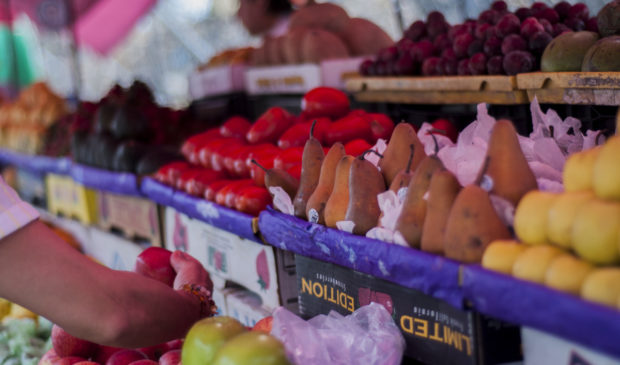City, county moving ahead with long-range local food plan
Tuesday, May 13, 2025 by
Chad Swiatecki The city will implement the joint Austin/Travis County Food Plan under a new interlocal agreement approved by City Council last week, formally launching a 42-month process to build a more sustainable and equitable local food system.
Under the agreement, Travis County will pay the city up to $281,648 through September 30, 2028, to oversee the initial phase of implementation. The agreement does not require the City to contribute funding, but formalizes a partnership in which the city will provide staffing, oversight, and contract management while the County contributes resources to support implementation.
The Office of Climate Action and Resilience will serve as the lead department, managing a competitive solicitation process to identify a community-based organization that will administer a new food systems collaborative. The collaborative is a central component in the adopted Food Plan, which calls for a stakeholder network to guide the plan’s goals and promote broad community participation.
The plan was initiated by a 2021 Council resolution and formally adopted in October 2024. Travis County Commissioners approved their own resolution of support later that same month, with county funding supporting the creation and operation of the collaborative that is expected to include nonprofits, food businesses, educators, government agencies, funders, and individual residents.
The urgency of building a resilient local food system has been underscored by recent cuts to federal nutrition programs, which have significantly strained food assistance services across Central Texas. In April, the Central Texas Food Bank announced it was forced to cancel more than 716,000 meals due to the expiration of USDA programs, including the Local Food Purchase Assistance Cooperative Agreement Program and Local Food for Schools Program. The cuts represent a loss of more than 913,000 pounds of food that would otherwise have been distributed to families in need, including fresh produce, proteins, and dairy products.
Via email, Mayor Pro Tem Vanessa Fuentes said during upcoming budget negotiations the city will examine how much assistance it can provide to fill in gaps in the local food supply.
“The City regularly steps up to meet the community’s needs when the state or federal government won’t,” wrote Fuentes. “The City currently contracts with the Central Texas Food Bank to support local food distribution and home delivery services, helping working families put food on the table every night. Considering budget restrictions, the City will have to assess during the budget process how much more support can be offered to fill in the many gaps created by the federal government.”
The food bank now reports serving more families than during the height of the Covid-19 pandemic, while spending approximately $1 million per month to make up for the shortfall in Austin. Community organizations such as the African American Youth Harvest Foundation have also reduced pantry hours due to limited supply.
Fuentes said she wants to draw attention to components of the plan related to growth pressures and other factors that cause fragility and instability in the production and availability of food produced locally.
“I am prioritizing the strategies within the Plan that address racial inequities and have a large impact on displacement, food access and insecurity, food workers, emergency food preparedness and response, and agricultural land,” said Fuentes. “We lose 13 acres of farmland every day, this itself should be a call to protect our local farmland and support working farms. By growing and buying food locally, we can keep our dollars within the community and foster the local economy. A thriving local food system also creates employment opportunities across the supply chain, from farmers to food distributors – further strengthening our local food economy.”
Council Member Mike Siegel said he would like the city and county to explore taking unused pieces of land owned by either entity and making them available to local farmers in order to increase food production.
“Right now, knowing we are facing budget shortfalls and economic instability, Austin must take stock of what we have and work to use it to make the greatest impact. The Food Plan does a great job of laying out this framework in multiple areas,” he said. “For example, the City of Austin and Travis County own quite a bit of land. A lot of that land is undeveloped. Some is undevelopable. Some is in flood plains. That land is an opportunity. Right now those parcels cost us money to maintain. Instead we can make them available to local farmers who are eager to grow food for our community but can’t afford to lease or purchase farms otherwise.”
The city will be responsible for selecting a collaborative administrator by October 15 of this year. That subcontractor will be tasked with convening stakeholders, coordinating strategy priorities, developing funding partnerships, and launching a public-facing progress dashboard. The administrator must also ensure that participation in the collaborative addresses barriers such as transportation, language, or family care and develop a leadership structure that reflects the diversity of the broader food system.
The city will staff three key positions to manage the contract and engage with the Austin-Travis County Food Policy Board, which will receive regular updates and may serve in a liaison role to the collaborative.
Quarterly progress reports will begin in early 2026 and continue until the collaborative is formally launched. Additional performance metrics, including demographic and geographic participation data, are scheduled to be developed by September 30, 2025.
The Austin Monitor’s work is made possible by donations from the community. Though our reporting covers donors from time to time, we are careful to keep business and editorial efforts separate while maintaining transparency. A complete list of donors is available here, and our code of ethics is explained here.
You're a community leader
And we’re honored you look to us for serious, in-depth news. You know a strong community needs local and dedicated watchdog reporting. We’re here for you and that won’t change. Now will you take the powerful next step and support our nonprofit news organization?




